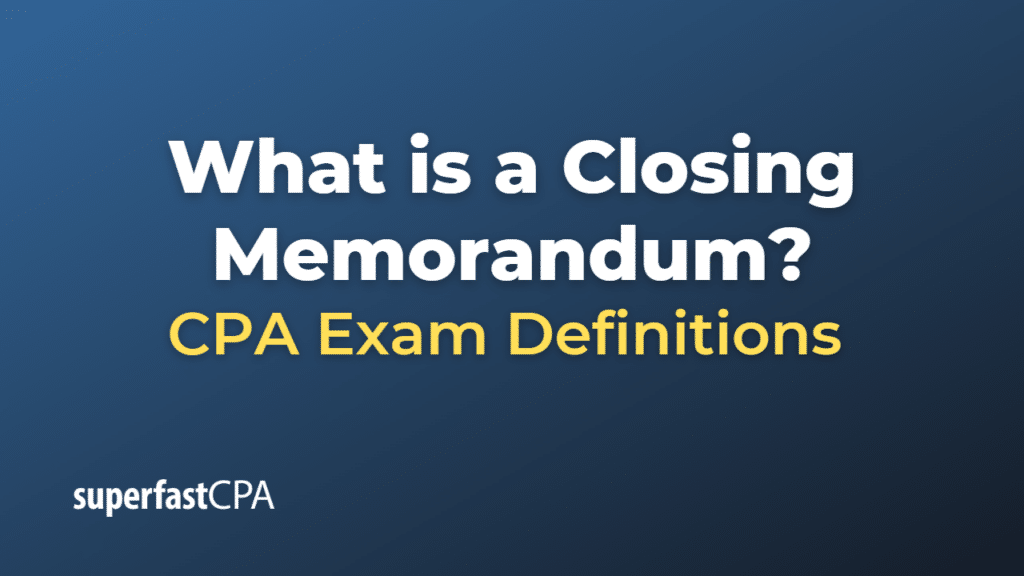Closing Memorandum
A closing memorandum, also known as a closing memo or deal summary, is a document that summarizes the key terms, conditions, and important details of a completed transaction, such as a merger, acquisition, or financing deal. It serves as a record of the transaction and helps to ensure that all parties involved have a clear understanding of the agreement and their respective obligations.
Closing memorandums are typically prepared by the legal team, investment bankers, or other advisors involved in the transaction. The document may include the following information:
- Overview of the transaction: A brief description of the deal, including the parties involved, the type of transaction, and the purpose of the transaction.
- Key terms and conditions: The significant terms and conditions of the deal, such as purchase price, payment terms, financing arrangements, representations and warranties, covenants, and indemnification provisions.
- Timelines and milestones: Important dates and milestones related to the transaction, including the signing date, closing date, and any post-closing obligations or deadlines.
- Regulatory approvals and filings: A summary of any required regulatory approvals or filings, such as antitrust clearance, SEC filings, or foreign investment approvals.
- Post-closing actions and obligations: A description of any actions or obligations that the parties need to undertake after the closing, such as integration activities, employee matters, or ongoing reporting requirements.
The closing memorandum is often shared with key stakeholders, such as the board of directors, management team, and investors, to inform them about the transaction’s details and implications. While the closing memorandum is not a legally binding document, it is a useful tool for organizing and communicating the essential elements of a complex transaction.
Example of a Closing Memorandum
Let’s consider a fictional acquisition of Company B by Company A. In this scenario, Company A is a large software company looking to expand its product offerings by acquiring Company B, a smaller company that specializes in cybersecurity software. The following is an example of a closing memorandum for this acquisition:
Closing Memorandum: Acquisition of Company B by Company A
- Overview of the transaction Company A has successfully acquired 100% of the outstanding shares of Company B through a share purchase agreement. The purpose of this acquisition is to expand Company A’s product portfolio by integrating Company B’s cybersecurity software and expertise.
- Key terms and conditions
- Purchase price: Company A has acquired Company B for a total purchase price of $75 million, consisting of $60 million in cash and $15 million in Company A’s common stock.
- Representations and warranties: Both parties have provided customary representations and warranties in the share purchase agreement.
- Covenants: Both parties have agreed to customary covenants, including non-compete and non-solicitation clauses for key employees of Company B.
- Indemnification: Both parties have agreed to indemnification provisions to protect against potential liabilities and breaches of the share purchase agreement.
- Timelines and milestones
- Signing date: The share purchase agreement was signed on July 1, 2023.
- Closing date: The transaction closed on August 15, 2023, following the completion of all required regulatory approvals and satisfaction of closing conditions.
- Post-closing obligations: Company A and Company B have agreed to complete the integration of their respective businesses within six months of the closing date.
- Regulatory approvals and filings The acquisition was subject to regulatory approvals, including antitrust clearance. All necessary approvals and filings have been obtained and completed.
- Post-closing actions and obligations
- Integration: Company A will integrate Company B’s software and employees into its organization, including merging the sales and marketing teams and consolidating the product development departments.
- Employee matters: Company A will offer employment to all Company B employees, with retention bonuses for key personnel.
- Ongoing reporting requirements: Company A will provide regular updates to its investors and regulators on the progress of the integration, as required by law.
This closing memorandum provides a summary of the acquisition of Company B by Company A, including key terms and conditions, timelines, regulatory approvals, and post-closing obligations. By documenting these important details, the closing memorandum serves as a reference point for both companies, their advisors, and other stakeholders involved in the transaction.












